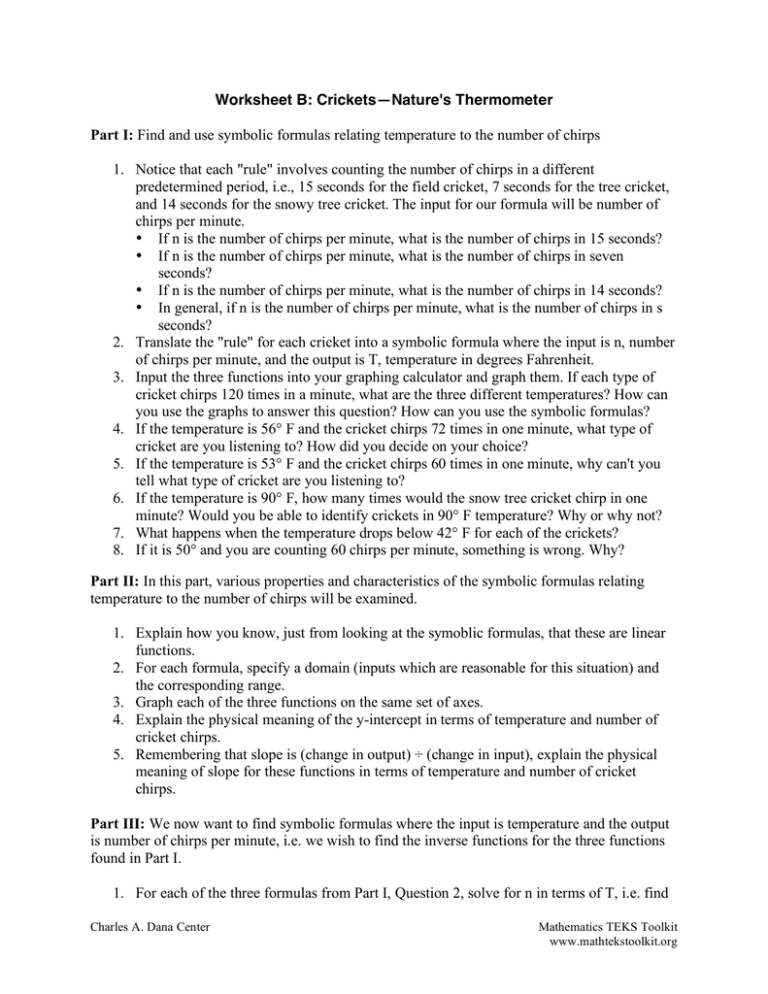Worksheet B: Crickets—Nature's Thermometer Part I:
advertisement

Worksheet B: Crickets—Nature's Thermometer Part I: Find and use symbolic formulas relating temperature to the number of chirps 1. Notice that each "rule" involves counting the number of chirps in a different predetermined period, i.e., 15 seconds for the field cricket, 7 seconds for the tree cricket, and 14 seconds for the snowy tree cricket. The input for our formula will be number of chirps per minute. • If n is the number of chirps per minute, what is the number of chirps in 15 seconds? • If n is the number of chirps per minute, what is the number of chirps in seven seconds? • If n is the number of chirps per minute, what is the number of chirps in 14 seconds? • In general, if n is the number of chirps per minute, what is the number of chirps in s seconds? 2. Translate the "rule" for each cricket into a symbolic formula where the input is n, number of chirps per minute, and the output is T, temperature in degrees Fahrenheit. 3. Input the three functions into your graphing calculator and graph them. If each type of cricket chirps 120 times in a minute, what are the three different temperatures? How can you use the graphs to answer this question? How can you use the symbolic formulas? 4. If the temperature is 56° F and the cricket chirps 72 times in one minute, what type of cricket are you listening to? How did you decide on your choice? 5. If the temperature is 53° F and the cricket chirps 60 times in one minute, why can't you tell what type of cricket are you listening to? 6. If the temperature is 90° F, how many times would the snow tree cricket chirp in one minute? Would you be able to identify crickets in 90° F temperature? Why or why not? 7. What happens when the temperature drops below 42° F for each of the crickets? 8. If it is 50° and you are counting 60 chirps per minute, something is wrong. Why? Part II: In this part, various properties and characteristics of the symbolic formulas relating temperature to the number of chirps will be examined. 1. Explain how you know, just from looking at the symoblic formulas, that these are linear functions. 2. For each formula, specify a domain (inputs which are reasonable for this situation) and the corresponding range. 3. Graph each of the three functions on the same set of axes. 4. Explain the physical meaning of the y-intercept in terms of temperature and number of cricket chirps. 5. Remembering that slope is (change in output) ÷ (change in input), explain the physical meaning of slope for these functions in terms of temperature and number of cricket chirps. Part III: We now want to find symbolic formulas where the input is temperature and the output is number of chirps per minute, i.e. we wish to find the inverse functions for the three functions found in Part I. 1. For each of the three formulas from Part I, Question 2, solve for n in terms of T, i.e. find Charles A. Dana Center Mathematics TEKS Toolkit www.mathtekstoolkit.org 2. 3. 4. 5. 6. 7. 8. the inverse function. What is the domain and range of each of your inverse functions? How does this compare with your domain and range for each of the three original functions? What is the slope of each of the inverse functions? How does this compare with the slope of each of the original functions? If it is 70° F, how many chirps will each cricket produce in one minute? Graph the three inverse functions on the same set of axes. In Part I, Question 5, you saw that data of 53° and 60 chirps per minute would mean that you can't tell between a field cricket and a tree cricket. Are there data points that would leave you unable to decide between a field cricket and a snowy cricket? How about a tree cricket and a snowy cricket? Give a quick way of telling, for any temperature in the range 40° F to 80° F, which cricket chirps at the highest rate. The slope of a line tells one how "steep" the line is. If you have two lines, is it always true that the line with the largest slope gives the greatest output? Explain your answer. How does this relate to your answer to the previous question? Charles A. Dana Center Mathematics TEKS Toolkit www.mathtekstoolkit.org






